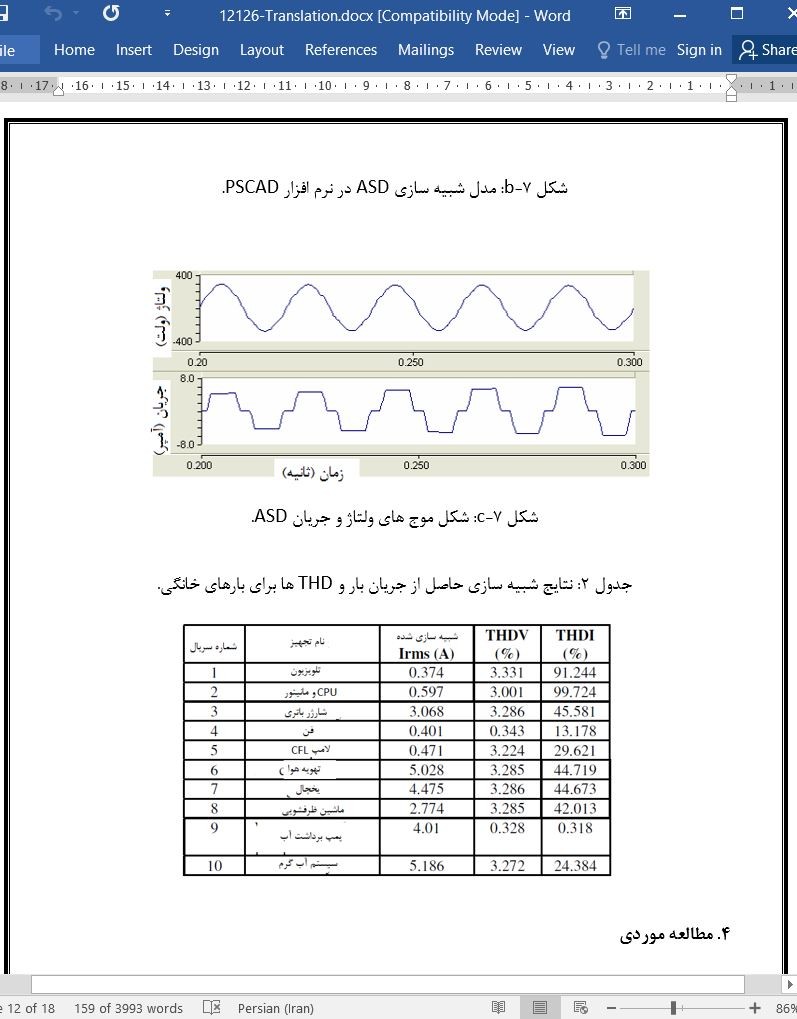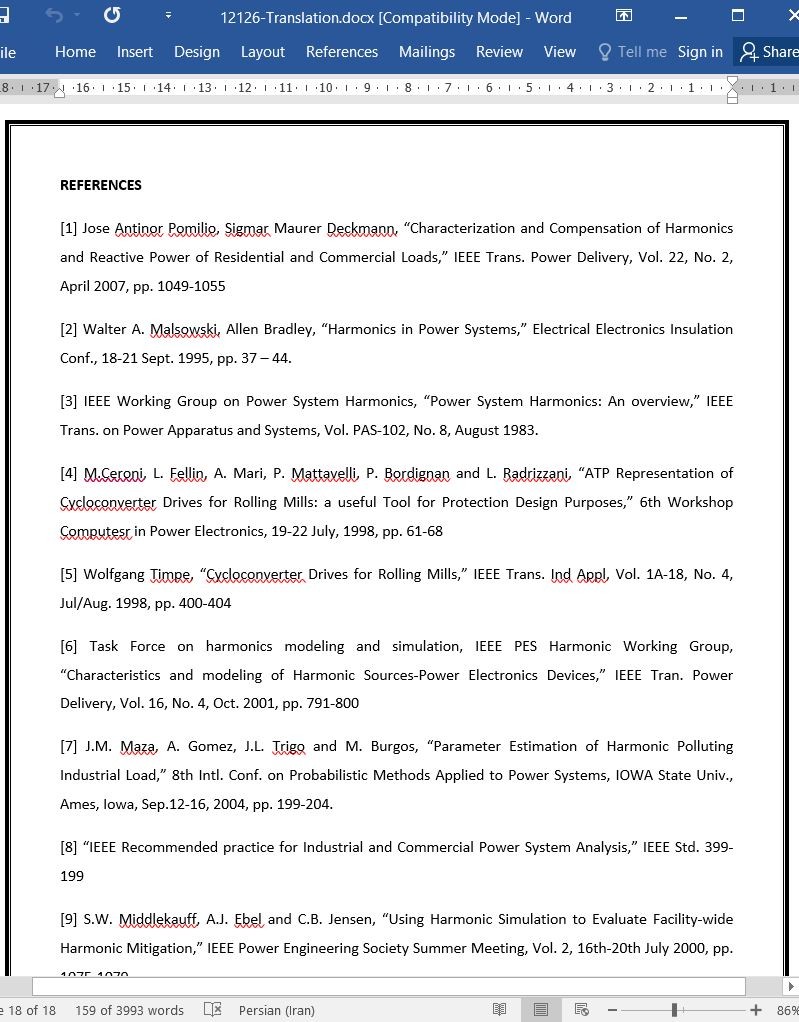
مدل سازی بارهای غیرخطی و تخمین هارمونیک ها در سیستم توزیع صنعتی
چکیده
این مقاله درباره مدل سازی بارهای الکتریکی غیرخطی مورد استفاده در سیستم های توزیع خانگی و صنعتی در مقیاس کوچک بحث می کند. تحلیل هارمونیکی سیستم توزیع در مطالعه رفتار تجهیزات متصل به محیط غیر سینوسی سیستم به منظور طراحی و مکان یابی بهینه فیلترها الزامی است. مدل های شبیه سازی برای بارهای غیرخطی مختلف مبتنی بر شکل موج های عملیاتی ولتاژ و جریان به دست آمده در آزمایشگاه توسعه داده می شوند. تحلیل هارمونیک های ولتاژ و جریان برای این بارها به صورت انفرادی انجام می شود. این مدل ها برای تحلیل هارمونیکی مدل های عمومی خانگی و صنعتی مورد استفاده قرار می گیرند. THD به عنوان شاخص هارمونیک برای مطالعه اثر بارهای غیرخطی در صنعت برق مورد استفاده قرار می گیرد. اعتبارسنجی مدل های بار با اجرای مطالعه موردی برای یک سیستم عرضه صنعتی و مقایسه THDهای به دست آمده از شبیه سازی با استفاده از بسته نرم افزاری PSCAD/EMTDC همراه با مقادیر THD به دست آمده از اندازه گیری انجام می شود.
1. مقدمه
هدف صنعت برق تامین ولتاژ سینوسی با اندازه و فرکانس نسبتاً ثابت برای مشتریان است. ژنراتورهایی که توان الکتریکی را تولید می کنند، تقریب بسیار نزدیکی از سیگنال سینوسی را تولید می کنند. با این حال، بارها و دستگاه هایی در سیستم وجود دارد که دارای مشخصات غیرخطی هستند و منجر به توزیع هارمونیک سیگنال های ولتاژ و جریان می شوند. از آنجا که بیشتر بارهای غیرخطی در یک ساختار معرفی می شوند، این شکل موج ها بیشتر دچار اعوجاج می شوند.
5. نتیجه گیری
تحلیل هارمونیک سیستم توان برای مطالعه رفتار سیستم تحت هارمونیک ها و انجام اقدام پیشگیرانه برای بهبود ضریب توان یا حداقل کردن تلفات انجام می شود. این مقاله مدل سازی شبیه سازی بارهای غیرخطی مختلف مورد استفاده برای کاربردهای خانگی و صنعتی را نشان می دهد. مطالعه موردی مربوط به تحلیل هارمونیک با استفاده از این مدل ها برای سیستم توزیع Cartosat-2A در ISRO در بنگلور انجام می شود. THD به عنوان شاخص هارمونیک مورد استفاده قرار می گیرد و طیف هارمونیک برای هر بار و برای سیستم توزیع صنعتی ارائه شده است. نتیجه شبیه سازی مربوط به بهبود ضریب توان با افزودن بانک خازن نیز ارائه شده است. نتایج شبیه سازی مربوط به THD و ضریب توان با وچود مقادیر عملی قابل اندازه گیری قابل قبول هستند. در نتیجه این مدل ها برای تحلیل هارمونیکی یک سیستم عملی و طراحی یک فیلتر مناسب برای حذف هارمونیک ها در سیستم توزیع به کار گرفته می شوند.
Abstract
This paper discusses the modeling of nonlinear electrical loads used in domestic and small scale industrial distribution systems. Harmonic analysis of the distribution system is essential to study the behavior of equipments connected in the non-sinusoidal system environment for designing and optimal location of filters. Simulation models are developed for various nonlinear loads based on practical waveforms of voltage and current obtained in the laboratory. Analysis of voltage and current harmonics is performed for these loads individually. These models are used for harmonic analysis of typical domestic and industrial loads. THD is used as the harmonic index to study the effect of these nonlinear loads at the utility. Validation of the load models is done by performing case study for an industrial supply system and comparing the THDs obtained from simulation using PSCAD/EMTDC package with the THD values obtained by measurement.
I. INTRODUCTION
This the objective of the electric utility to supply its customers with a sinusoidal voltage of fairly constant magnitude and frequency. The generators that produce the electric power generate a very close approximation to a sinusoidal signal. However, there are loads and devices on the system which have nonlinear characteristics and result in harmonic distortion of both the voltage and current signals. As more nonlinear loads are introduced within a facility, these waveforms get more distorted.
V.CONCLUSION
Harmonic analysis of power system is performed to study the system behavior under harmonics and take preventive action to improve the pf or minimize losses. This paper presented the simulation modeling of various nonlinear loads used for both domestic and industrial applications. Case study of harmonic analysis is performed using these models for Cartosat-2A distribution system at ISRO, Bangalore. THD is used as the harmonic index and harmonic spectrum is presented for each load and for the industrial distribution system. Simulation result of power factor improvement by the addition of capacitor bank is also presented. The simulation results of THD and pf are acceptable with the practical measurement values. These models can hence be employed for harmonic analysis of a practical system and to design a suitable filter to mitigate harmonics in the distribution system.
چکیده
1. مقدمه
2. توان و هارمونیک ها در سیستم سینوسی
3. مدل سازی بارهای خانگی/ صنعتی
A. رایانه شخصی (PC)
B. لامپ فورسنت
C. درایو قابل تنظیم سرعت (ASD)
4. مطالعه موردی
5. نتیجه گیری
منابع
Abstract
1. INTRODUCTION
2. POWER AND HARMONICS IN NONSINUSOIDAL SYSTEM
3. MODELLING OF DOMESTIC/INDUSTRIAL LOADS
A. Personal Computer (PC)
B. Fluorescent Lamp
C.Adjustable Speed Drive (ASD)
4. CASE STUDY
5.CONCLUSION
REFERENCES
- اصل مقاله انگلیسی با فرمت ورد (word) با قابلیت ویرایش
- ترجمه فارسی مقاله با فرمت ورد (word) با قابلیت ویرایش، بدون آرم سایت ای ترجمه
- ترجمه فارسی مقاله با فرمت pdf، بدون آرم سایت ای ترجمه



